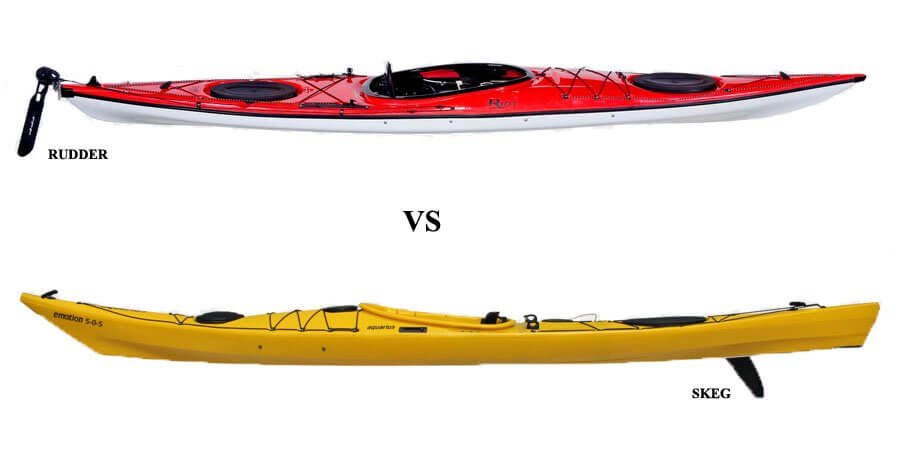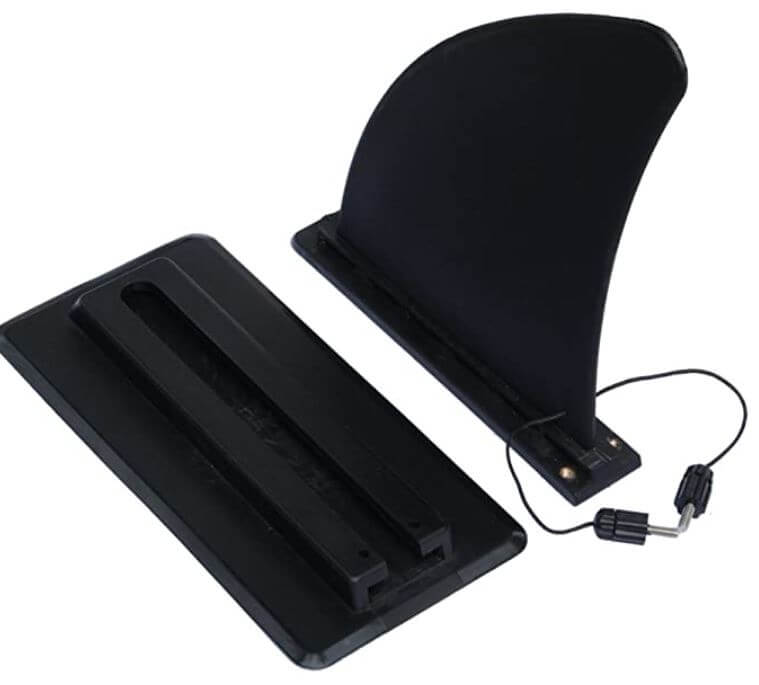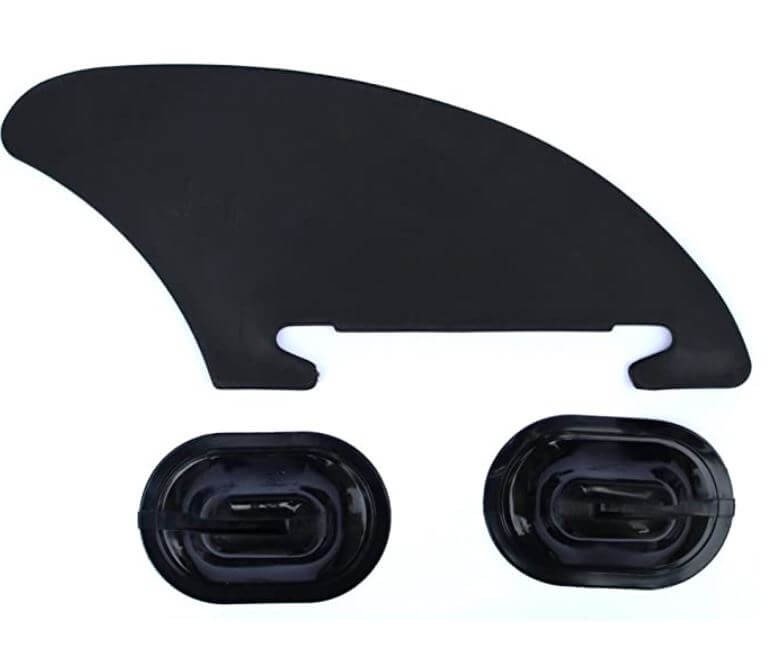When sailing over choppy waters, a skeg can potentially take some of the work out of paddling and make the overall kayaking experience smoother.
In this short brief, we’ll visit some of the features of skegs to help you decide whether a skeg is something your kayak could benefit from or not. We’ll start answering the question: what is a skeg. Next, we’ll explore how it might enhance your experience and lay out some pointers on how you can attach one to your craft.
Skeg – What is it?
A skeg is a nice contraption that helps kayakers track better. It’s consists of a mounting and a fin that attach under your vessel on the keel. Many models on the market come with pre-installed skegs but many others don’t. So, for those of us who don’t have one already installed in their vessels, it’s worthwhile to dive a little into its functions before making any purchase decision.
In terms of location, a skeg goes under the hull, on the stern side of your vessel, at the keel’s center. It is shaped like a fin which is either immovable or can be retracted back into the hull in times when it’s not required.
So, What Purpose Does A Skeg Serve? How Important Is A Skeg?
A Skeg helps to anchor the stern (the rear end) of your vessel which makes it easier to control the heading of the kayak and keeps it moving straight ahead. This becomes very useful when you’re paddling on open waters or when strong winds are blowing.
Usually, skegs come with kayaks designed for touring or long excursions. This is because when winds are strong or when the kayak is cruising on open water bodies, kayaks can often come to sail against the wind. A skeg on a kayak can offset this effect by keeping your bow (the front end of your craft) facing the direction you’re heading.
This means if you mostly indulge in recreational kayaking, having a skeg attached to your kayak may not be necessary. And especially if the waters you paddle in frequently are shallow, rocky, or both – having a skeg is not recommended because these environments pose additional risks to your skeg. What this means is a skeg-loaded craft is unsuitable for creek or whitewater paddling.
Are Rudder & Skeg The Same? Rudder Vs Skeg

The differences lie in the design and the points they’re attached to a kayak. While both are located on the stern side of the craft, a rudder system is usually operated from the cockpit, through either hand or foot. The fin here is much more elongated and can be rotated – even moved vertically. Additionally, a rudder allows the user the flexibility to deploy or retract it according to need.
A skeg, in contrast, cannot be moved sideways – though it can be pulled up to the hull to different degrees when not it’s not needed. But that’s true only for adjustable kayaks. For fixed skeg designs, it can’t be moved at all.
So, in summary, while skeg and a rudder are two distinct parts of a vessel – they are both useful. And the question of whether skeg is a worthy addition to any craft depends upon the kayak’s environment.
3 Recommended Skegs For Kayaks And Canoes
1. Kayak Skeg Tracking Fin (unbranded)

A nice thing about this skeg is It can be fitted on both kayaks & other small vessels. In terms of design, it has a platform and an 8’’ fin that can be adjusted and locked into the mount. This allows the user to remove the fin and still have the mounting in place when you don’t need it.
Another plus is you can mount it on your craft’s hull without the aid of tools – though it’s advised that you use a suitable (PVC compatible) marine glue for that purpose.
2. Small Kayak Skeg (unbranded)

Small Kayak Skeg is designed in such a way that it too can be mounted to the keel of your craft using marine glue – so you don’t need fasteners like nuts or screws. Further, it comes with the required mounting attachments and, of course, a fin (measuring 4 inches).
Here too, the two mounting platforms can be attached using a PVC-safe marine glue – allowing the skeg to nicely fit the mounts. A benefit of this design and modularity is that a user can simply detach the fin when it isn’t needed – a feature that becomes very useful when you’re carrying your kayak overland or putting it away in your garage for storage.
3. MAYMII Mini Kayak Skeg

Perhaps the most prominent feature of this skeg – relative to the other skegs we’ve reviewed – is its fin. At only 2.75’’, the fin is quite small. But don’t make the mistake of assuming its smaller size gets in the way of its performance. For shallower waters, where larger fins are more prone to damage, this compact design could prove to be a valuable paddling aid and give a boost to vessel’s tracking.
MAYMII Mini Kayak Skeg can be fitted on kayaks as well as other small vessels like canoes. And it too doesn’t require any tool for installation – only marine glue. But here, the fin and the mounting base are inseparable – so it’s not possible to remove just the fin.
How To Add A Skeg To A Kayak
This method should work with most kayaks, canoes and small boats.
Things You’ll Need:
- Marine glue
- Sandpaper
- A piece of cloth or a rag
- Hair dryer or heat torch (optional)
- Paddle leash (optional)
- Drill (optional)
Step 1 – Choose Mounting Location
The first thing to do when attaching a skeg to a kayak is to pinpoint the desired location. To do that, all you got to do is turn your vessel upside down and mark the best place on the keel for the skeg. The exact location varies – depending on the type of craft and hull’s shape – but a general rule of thumb is to attach it on the centerline of your keel, on the stern side.
Step 2 – Sand Surface
The next step is to sand the area of attachment on the keel using sandpaper. Doing this will smoothen the surface and promote a better binding between the skeg and the surface.
Step 3 – Remove Dust
After sanding, use a rag or piece of cloth to gently wipe off any dust residues from the previous step.
Step 4 – (Optional) Heat Hull
This step is optional. In case your vessel is made of polyethylene, you may benefit from slightly heating the region of the keel that you want to mount the skeg on.
Step 5 – Apply Marine Adhesive
After preparing the target keel area, proceed to apply the marine glue, and attach the mounting frame to the hull. Apply gentle hand pressure or use a weighted object to help the frame stick. Doing this should allow you to strengthen the bond between the hull and your skeg base.
Step 6 – Attach Fin (if necessary)
After the glue has dried, you can proceed to slide or attach the fin to the newly attached base. If your mounting comes with fin pre-attached; you don’t need to worry about this step.
Step 7 – Attach Leash (optional)
In case you feel the need to take extra precautions to prevent your skeg from getting torn away from its mounting – or getting lost otherwise – you could drill a small hole in the back of the fin. This will allow you to attach a paddle leash so that your skeg won’t get lost even if it splits from the base upon hitting rocks or riverbeds.
Skegs On Inflatable Kayaks?
For inflatable kayaks, you can either use the above steps to secure a skeg to your vessel or go for those skegs that don’t require gluing. These latter skegs have designated points of attachment and can be mounted using manufacturer-provided guidelines.
Conclusion
We hope after this brief overview of skegs, you’re now better positioned to decide whether your craft, outdoor conditions, and kayaking habits could use a skeg or not. Just to give you a recap, If you paddle frequently in open waters, where you come across crosswinds, a skeg might prove useful when it comes to keeping your heading.
What are your views on skegs for kayaks? If you’ve used one, do you think it enhanced your on-water experience? Let’s know in the comments below.
Happy kayaking!
